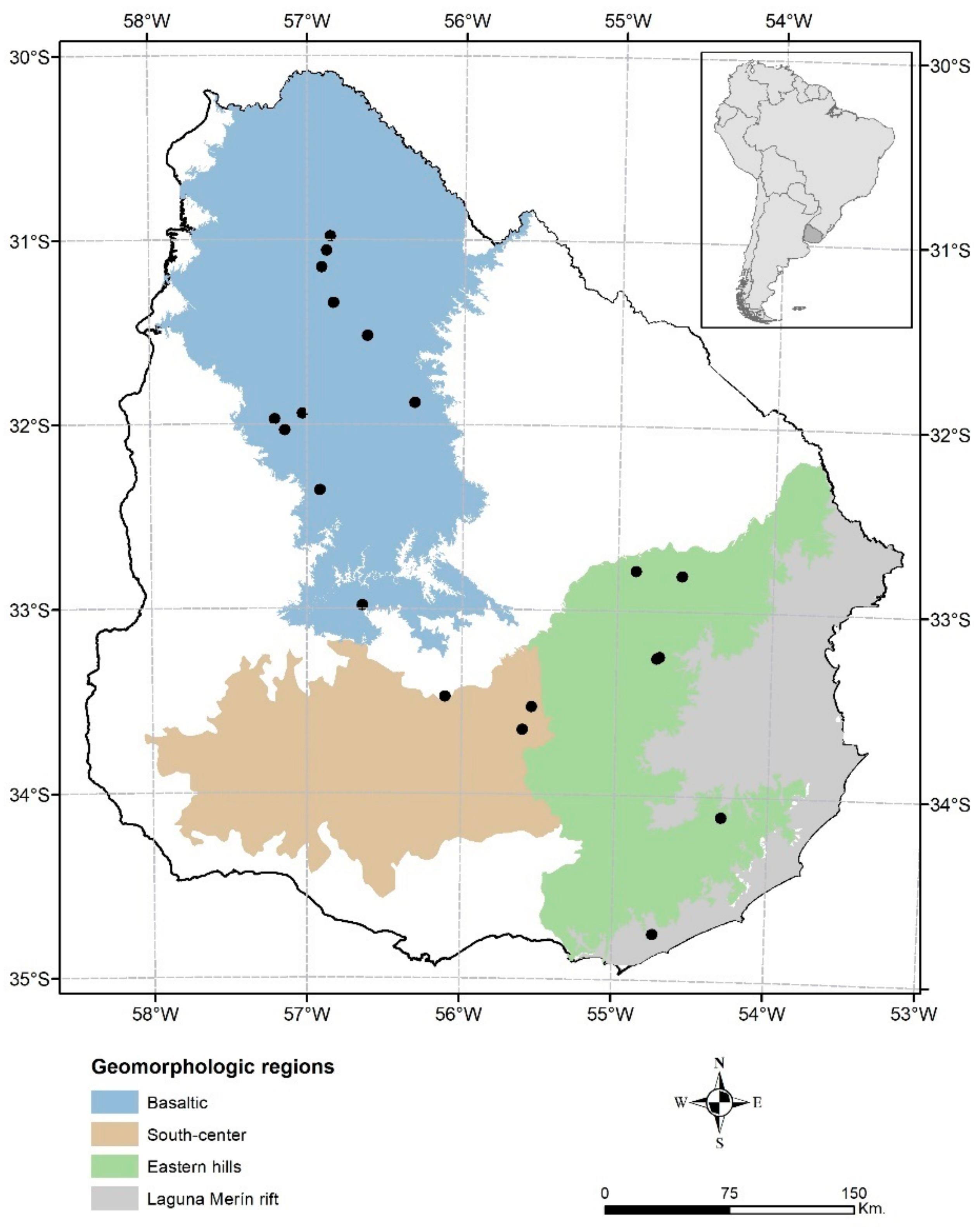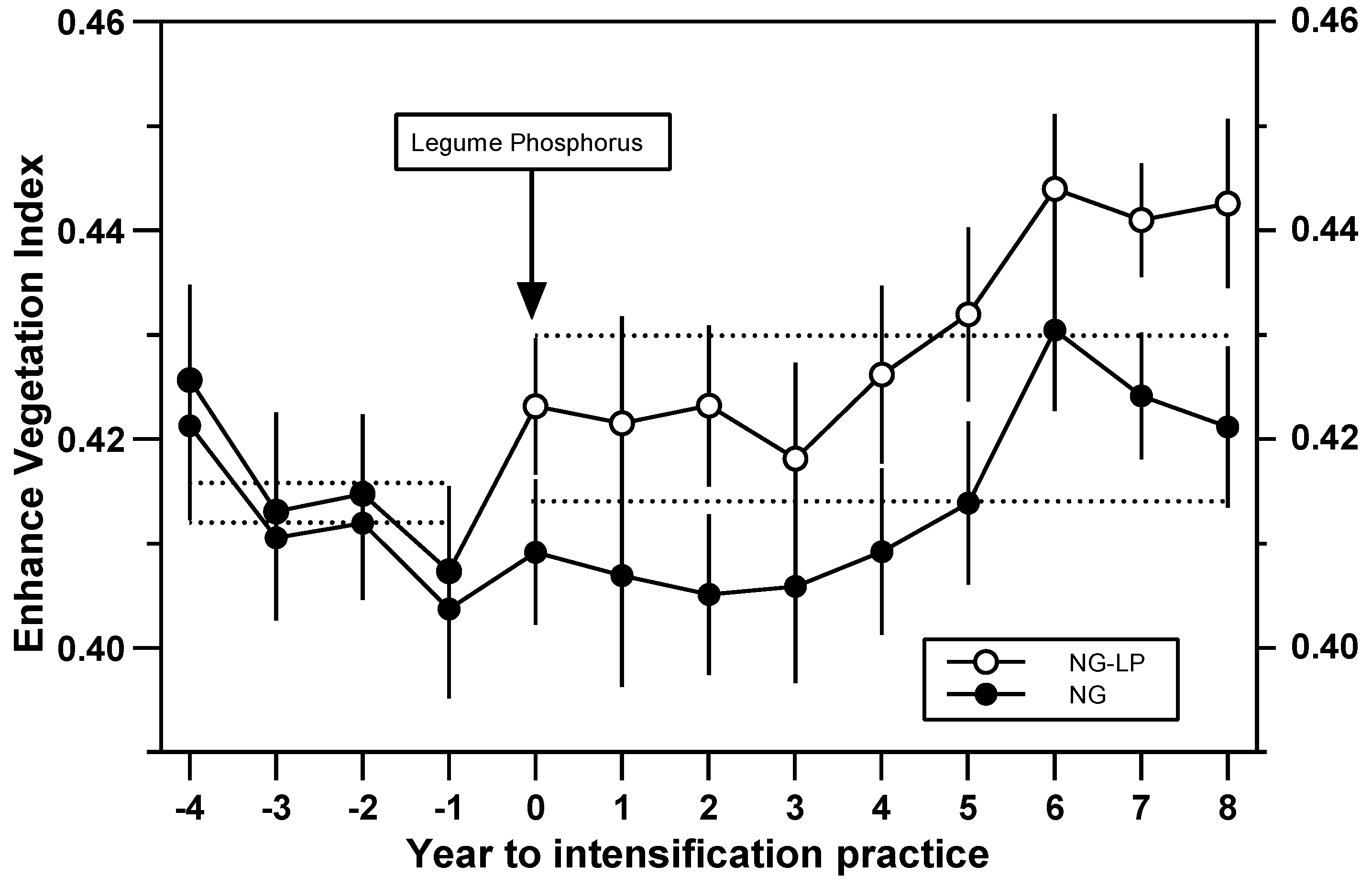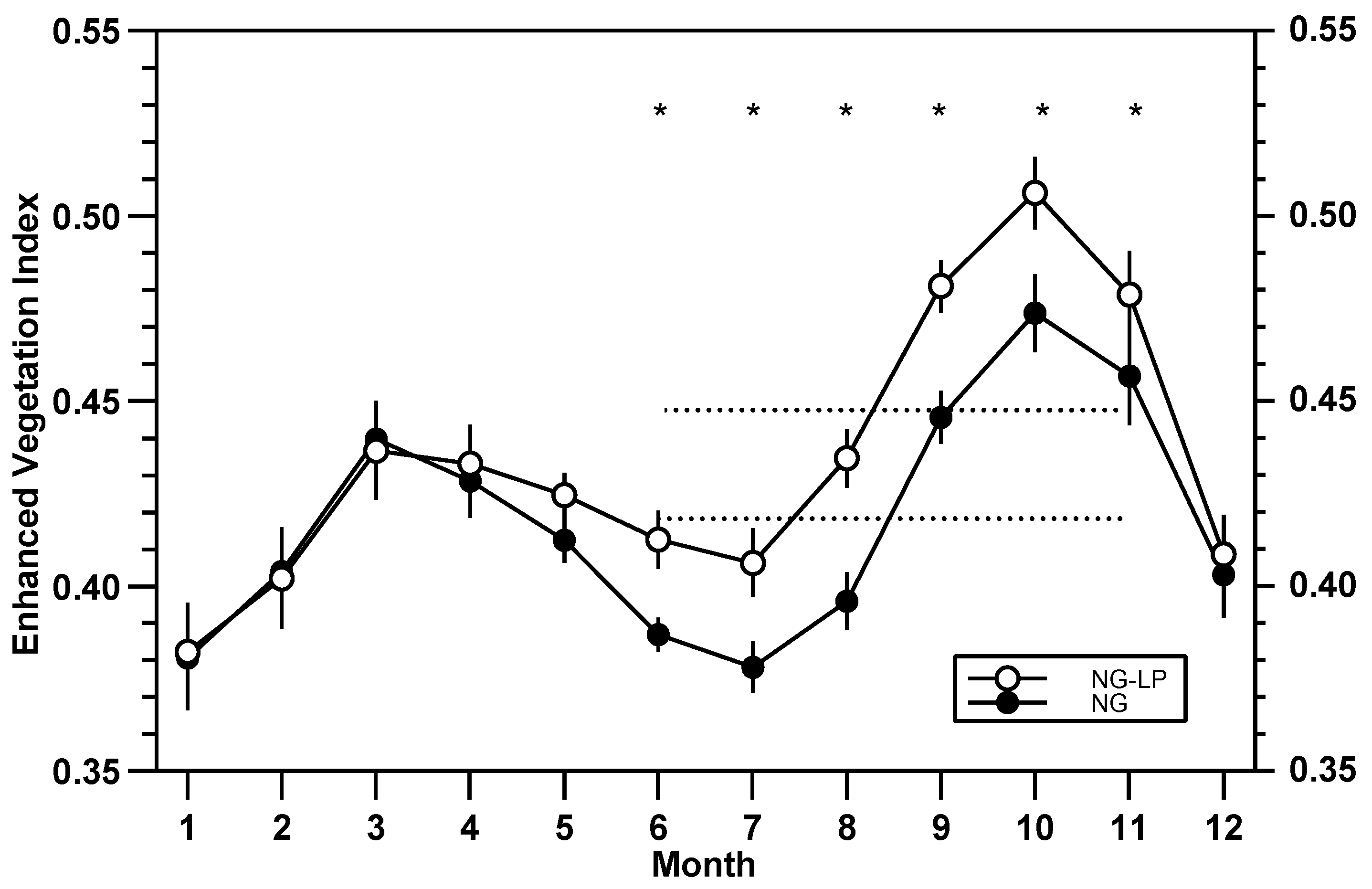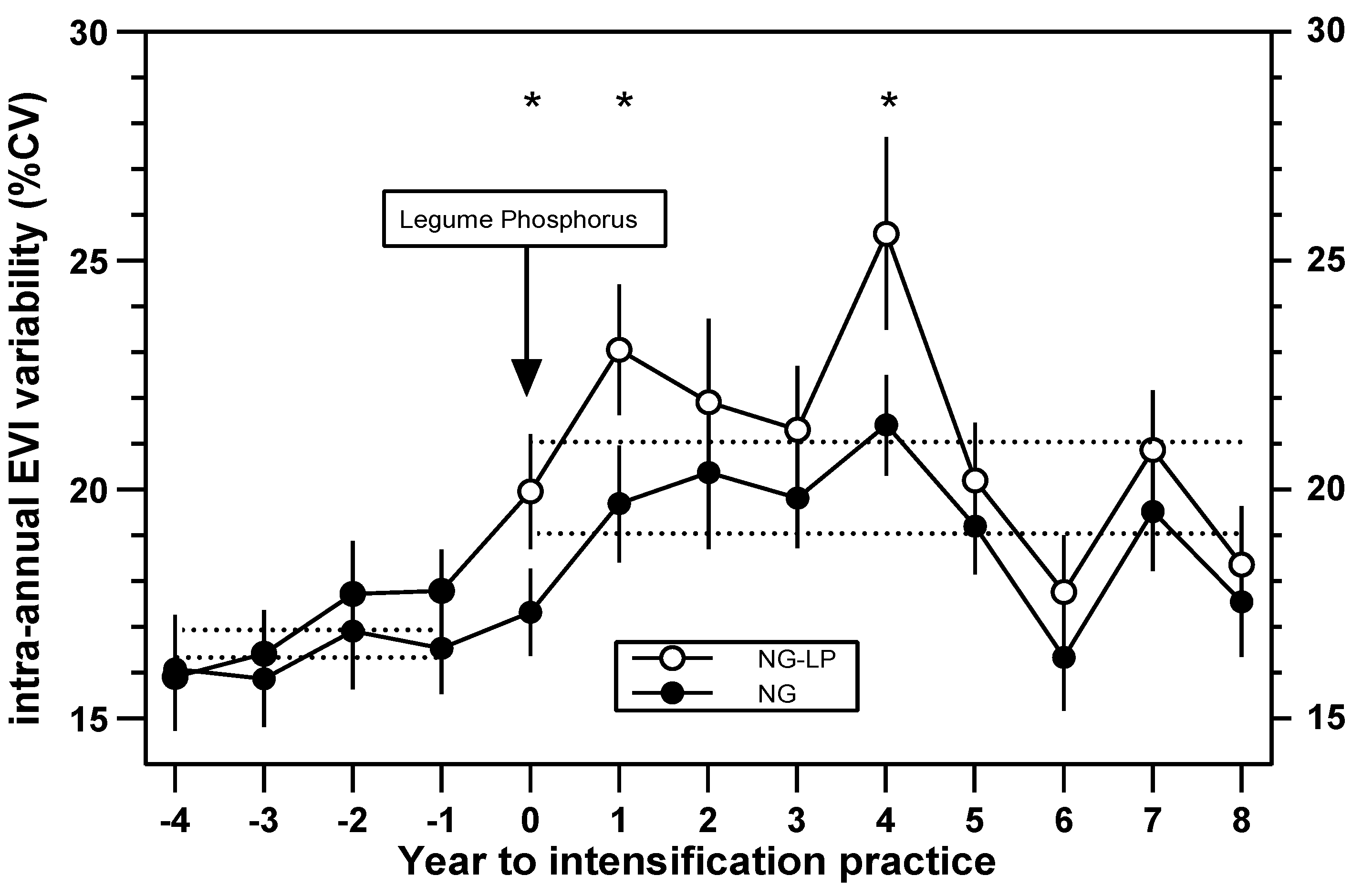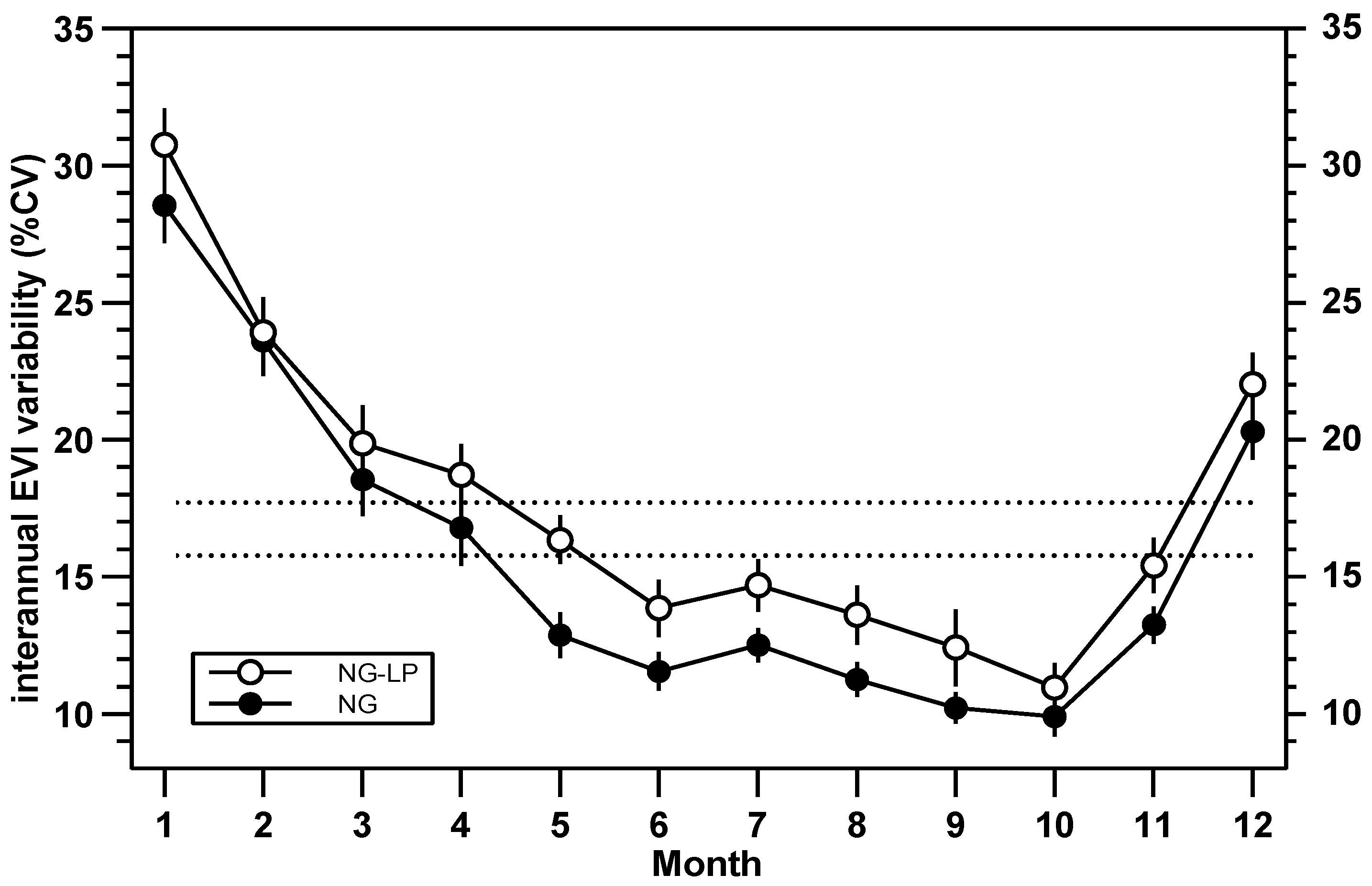This study shows, for the first time at the paddock level, that legume overseeding along with P fertilization increased forage production and its temporal variability of temperate natural grasslands. Medium-term forage production of NG-LP and its temporal variability has been scarcely evaluated beyond a few controlled experiments. Here, a database was carefully curated to use commercial farms as natural experiments. In this sense, each intensified paddock (NG-LP) was matched with a control paddock (NG) under same environmental and management conditions. In this way, potential covariables that could confound the effect generated by intensification on forage production were controlled. In addition, differences were evaluated also for four years before intensification practice, that allowed for the linking of forage production effects with the intensification practice.
4.1. Increase of Forage Production
These results showed that forage production of NG-LP was higher than that of NG, both at annual and seasonal resolutions. The forage production increase generated by this intensification practice has been reported in previous studies, mainly under experimental conditions and by repeated biomass harvests. In Uruguay, del Pino et al. [
31] found a forage production increase of 25% and 35%, eight years after an intensification practice with two levels of phosphorus fertilization, respectively. Also in Uruguay, Pañella et al. [
35], analyzed NG-LP with different phosphorus doses over three years at two sites, reporting forage production increases of approximately 90% and 130% for two fertilization levels in the first year and exclusively for one site. In Brazil, Ferreira et al. [
57] found even greater differences after one year of the intensification practice, with a forage production increase of 150%. As in this study, differences are concentrated in winter and spring, while in summer and autumn differences were not recorded [
57].
Some remote sensing studies that used vegetation indexes to estimate forage production agreed with the forage production increase of NG-LP found in these results. Baeza et al. [
52] estimated Radiation Use Efficiency (RUE) and grasslands forage production in the Eastern Hills region of Uruguay and report higher average values in NG-LP than in NG. They report that maximum of forage production of NG in November was doubled for NG-LP. In another study, Pagnanini et al. [
58] report higher forage production values in NG-LP than in NG, analyzing commercial farms in four geomorphological regions of Uruguay, but they did not perform the paired situations analysis used in this study.
Although EVI difference between NG and NG-LP obtained in this study is relatively small (4–7.5%), differences were amplified when models were used to estimate forage production. Using published national average values of incoming photosynthetically active radiation [
59], and radiation use efficiency calculated for NG and NG-LP for Uruguayan grasslands [
52], the 4% EVI difference between treatments amplified to 28% in terms of forage production (12,800 Kg DM ha
−1 y
−1 NG-LP vs. 7100 Kg DM ha
−1 y
−1 NG). If the June-November period is considered, difference is amplified to 33.8% (13,400 Kg DM ha
−1 y
−1 NG-LP vs. 7300 Kg DM ha y
−1 NG). These differences between treatments acquire similar values to the literature cited above.
The smaller difference in EVI found, a proxy of forage production, may be related to the differences in the situations analyzed. These results were obtained through a “natural experiment” in commercial farms and not in controlled experimental conditions as in previous references. The existence of covariates over which no control is available, are common in natural conditions experiments [
60]. Grazing management is potentially one of these uncontrolled variables. Grazing management recommendations in NG-LP include raising the stocking rate to control the legume cover dominance in the growing season and then remove livestock for approximately 40 days to promote seed development [
61]. Similar results were found by De keesmaecker et al. [
62], in a natural experiment in the Netherlands. These authors compare intensified pastures (with fertilization, sown pastures and irrigation) vs. semi-natural grasslands both under grazing and report an average increase of 10% in the Normalized Difference Vegetation Index (NDVI), accordingly with these results (considering the differences in intensification practices).
The persistence of the forage production increase caused by legume and P fertilization (NG-LP) is under discussion and there is not enough information on this issue. Del Pino et al. [
31], found increase in forage production in the first and last two measures of a total of six over eight years, only during intensification. In a more recent study, del Pino et al. [
45] found no differences after 12 years from the end of the intensification practice. This differs compared to these results, where the forage production increase remained in the medium-term, or during the nine years analyzed at least. A similar result was found by Jaurena et al. [
33], who reported a forage production average increase of 60% after 12 years of NG-LP under experimental conditions.
The forage production increase due to intensification practice can be explained by two reasons. One is the introduction of highly productive leguminous species, with rapid growth and winter cycle, the season with the lowest forage production in Uruguayan natural grasslands [
51,
52,
53]. Previous experimental studies reported a higher forage production of NG-LP that NG according to the season: 150% in winter and 100% in spring [
63,
64]. These results confirmed that the difference between NG and NG-LP is concentrated in June-November period, including the winter months when the higher forage production of NG-LP offsets the winter forage deficiency generally found in these systems. The second reason is higher plant availability of macronutrients which limit the NG forage production, particularly nitrogen fixed by legumes, and phosphorus by fertilization [
65]. It should be considered that NG-LP practice aims, besides increasing forage production, to improve its quality by increasing the amount of biomass N and P concentrations [
31]. Del Pino et al. [
45] reported quality improvement remains in NG-LP plots after 12 years of intensification practice, even though they did not detect forage production differences.
Some studies reported forage production increases in NG using different intensification input-based technologies. A medium-term experiment (seven years) showed an average increase of 29% with nitrogen plus phosphorus fertilization [
66], coinciding with these results. In a short-term experiment, Jaurena et al. [
67] observed a 50 % increase in forage production of NG with nitrogen plus phosphorus fertilization, and a 100% increase when fertilization was combined with irrigation. The differences can be explained by the addition of nitrogen, which becomes rapidly available and generates an increase of forage production of grasses, which are dominant in natural grassland [
67]. In addition, irrigation eliminates another of the main limiting factors of growth in temperate grasslands [
68], so a greater increase was observed. Some short-term experiments in the region observed increases similar to these. Rodríguez et al. [
69], observed increases of 40% and 100% in annual forage production through two levels of phosphorus fertilization in NG of Argentina’s Pampa region. Ferreira et al. [
57] found increases of 130% with combined nitrogen and phosphorus fertilization in southern Brazil grasslands.
4.2. Increase of Forage Production Variability
These results showed intra- and inter-annual increase of ecosystem functioning variability by NG-LP. The effect of NG-LP on temporal variability was scarcely addressed by the literature. Baeza et al. [
52] suggested the existence of greater inter-annual and intra-annual variation of forage production in NG-LP than in NG. Variability analysis of other intensification input-based technologies is a little more studied. A review of Jaurena et al. [
28] suggested that, after the fourth year of sowed pastures of Uruguay and Argentina, variability of forage production is three times higher than NG. Durante et al. [
70] analyzed the difference in forage production variability of sown pastures and NG in the Argentina’s Pampa region over a period of eight years and found greater intra- and inter-annual variability in sown pastures. This agreed with Paruelo et al. [
71], although they did not perform a comparative analysis, their results suggest greater interannual variation of forage production in sown pastures than NG in commercial farms of Uruguay.
An important part of the rise in intra-annual variability of NG-LP productivity is partially explained by the increase in the EVI range. Specifically, NG-LP minimum was equal to NG, but maximum values was higher mainly from September to November. The remaining variability could be explained by diversity loss and/or the change in species composition. Although it is generally accepted that NG-LP is an alternative option to preserve NG biodiversity, in comparison with high-level intensification input-based technologies such as sowing pastures, some local studies reported short-term loss of diversity. Jaurena et al. [
33], observed loss of total diversity, richness and increase frequency of exotics species in NG-LP versus NG. The higher-level of phosphorus fertilization used in this practice would generate a greater decrease in species, mainly native ones. Pañella et al. [
35] reported a decrease in the richness of native species and an increase in exotic species, in addition, native species loss was greater with higher fertilization levels. Del Pino et al. [
31] quantified the response of NG to phosphorus (P) fertilization and legume introduction, by measuring herbage yield of legumes and native species separately. Their results suggest the installation of legumes trigger a process of replacement of native species given by their greater competitive ability in situations of high resource availability. However, there is no consensus on long-term effects of NG-LP. Del Pino et al. [
45] found no changes in diversity or presence of exotic species in 12 years after the end of the intensification practice. In a 21 years-long experiment in Rio Grande do Sul (Brazil), which analyzed only phosphorus fertilization, Somavilla et al. [
72] reported changes in botanical composition, although not always with a decrease in species richness. In other regions of the world, numerous studies reported a decrease in NG diversity due exclusively to fertilization. Seabloom et al. [
73] analyzed the chronic effect of phosphorus and nitrogen fertilization in species diversity, in experiments lasting five to 11 years, at 47 grasslands sites in 12 countries in North and South America, Europe, Australia, Africa and Asia. In all cases, they reported a decrease in species diversity and richness by fertilization. Several studies found strong negative correlation between diversity and nitrogen enrichment by intensification [
74,
75,
76,
77]. Riesch et al. [
78], reported inverse relationship between species richness and soil phosphorus enrichment in intensified semi-natural grasslands in Germany [
78].
Positive correlations between diversity and stability have been reported for grassland systems globally. It is argued that species diversity increases ecosystem stability and resilience to major disturbances [
79] and it has been described that higher species richness is associated with increased biomass production and decreases temporal variability of forage production of grassland communities [
80]. Less diverse intensified grasslands were less resilient to drought than NG under controlled conditions [
81] and in natural experiments using vegetation indices [
62].
Several mechanisms may explain how species diversity mediate temporal variability of forage production in NG. The presence of higher species richness with a high functional diversity probably has a complementary effect stabilizing biomass production in the long term [
82]. Besides, heterogeneity associated with niche complementarity could result in better community performance compared to the expected individual species performance [
83]. In this sense, it has been described phenological diversity stabilized forage production at the community level [
84].
Another mechanism that may explain the temporal stability reduction is the substitution of native perennial species for annuals, as part of medium-term species alternation induced by intensification. Some studies report this effect after NG-LP in Uruguayan grasslands. Carámbula et al. [
61], found a higher frequency of winter annual grasses after intensification, including one exotic species. NG-LP Increased annual species cover and frequency of opportunistic species in two regions of Uruguay (Centro sur and Sierras del Este; Lezama, 2019, Comm Pers). Some studies report increases in annual species biomass by phosphorus fertilization in Rio de la Plata Grasslands. Rodríguez et al. [
69] analyzed the effect of fertilization in Pampean region (Argentina) and reported an increase in the productivity of annual C3 grasses and legumes in both seasons, suggesting a stability decrease of the natural community with the replacement of perennial species by annuals. Oliveira et al. [
85] reported an increase in annual species biomass with phosphorus fertilization in grasslands of southern Brazil. In this sense, they found that a change in functional groups in a grassland dominated by perennial species was the main driver of declining stability, even more important than diversity [
86]. In any case, links between both mechanisms, changes in diversity and functional groups caused by intensification practice and their consequences in functional stability of pastoral livestock systems remains to be elucidated.
4.3. Limitations
This natural experiment with commercial farms constitutes a challenge that presented at least two disadvantages and three advantages respect to field experiments under controlled conditions. Many disadvantages are related to the limited control associated with the wide diversity of management taken by each farmer. Firstly, the absence of grazing control is a key factor that affects the forage production for which there is not enough information. Secondly, the intensification treatment was considered as one factor, but it involved different legume species, types and doses of fertilization that will be examined in greater detail. Firstly, the most important advantage was the achievement of a large number of replications using case studies under a wide variety of local conditions. Secondly, the farms’ geographical dispersion in different grassland communities strengthened the results, finding intensification practice effects in spite of the great variation of environmental conditions (edaphic and climatic). Thirdly, control paddock use and pre-post intensification practice analysis allowed for the attribution of inputs on the effects of forage production exclusively, in spite of the different conditions.
This study was limited by the sensor spatial resolution. The MODIS sensor is robust and presents an adequate temporal resolution for this study, but its spatial resolution of 250 m limiting at the paddock scale. Recent studies have used harmonized time series of vegetation indices with higher spatial resolution sensors such as LANDSAT and SENTINEL [
87,
88,
89]. With a higher spatial resolution, the number of cases could be increased, even to databases of controlled plot-scale experiments, analyzing possible nested or treatment-specific effects, such as the differing legume species seeded (summer or winter cycle), fertilizer load or the community grassland location.
